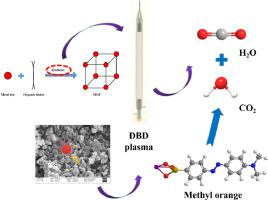Journal of the Taiwan Institute of Chemical Engineers ( IF 5.5 ) Pub Date : 2021-11-11 , DOI: 10.1016/j.jtice.2021.10.033 Xianghui Jin 1 , Tao Tang 1 , Xumei Tao 1 , Liang Huang 2 , Shuyong Shang 3

|
Background
In order to make Fe-MOFs more fully utilized sunlight, more metal active sites were required to activate the reactants. The design of the materials with structure exposing more active sites became one of the most critical factors to improve catalytic performance.
Methods
A novel dual-ligand Fe-MOFs, with N-containing ligands for regulation of active sites, were synthesized with dielectric barrier discharge (DBD) plasma for the first time. 1,3,5-benzenetricarboxylicacid (H3BTC) was used as organic ligands, while 2-methylimidazole (2MI) was added together for regulation of active sites.
Significant findings
N-Fe-MOFs-2 with FeCl3•6H2O and ligands molar ratio of 1:2 exhibited the best photocatalytic performance. N-Fe-MOFs-2 had higher N content, which was conductive to anchoring Fe and provided more sites for the anchoring of metallic Fe. N-Fe-MOFs-2 showed larger specific surface area (70.18 m2/g) and relative smaller particle size (55 nm), and exhibited narrow band gap (2.55 eV), which was beneficial to the transportation of photonics. N-Fe-MOFs-2 exhibited lower PL intensity, which meant the lower photo-generated electron-hole recombination rate and showed higher photocatalytic performance with degradation rate of 97% in 48 min for methyl orange (20 mg/L) under visible light. EPR proved that superoxide radical anions (•O2−) and oxhydryl (•OH) radicals played important roles during photocatalytic. Radical capture experiments confirmed that holes (h+) and electron (e−) were major active species for the photodegradation of MO dye, •OH and •O2− radicals played minor role in the photo-decomposition of MO. What's more, the possible photocatalytic mechanism of N-Fe-MOFs was proposed, both degradation pathways and degradation intermediate products were confirmed via LC-MS.
中文翻译:

调节 N 含量以锚定 Fe-MOFs 中的 Fe:获得多个活性位点作为高效光催化剂
背景
为了使 Fe-MOFs 更充分地利用阳光,需要更多的金属活性位点来激活反应物。具有更多活性位点结构的材料设计成为提高催化性能的最关键因素之一。
方法
首次用介电势垒放电(DBD)等离子体合成了一种新型双配体 Fe-MOF,其具有用于调节活性位点的含 N 配体。1,3,5-苯三甲酸(H 3 BTC)作为有机配体,同时加入2-甲基咪唑(2MI)调节活性位点。
重要发现
FeCl 3 •6H 2 O和配体摩尔比为1:2的N-Fe-MOFs-2表现出最好的光催化性能。N-Fe-MOFs-2具有较高的N含量,有利于锚定Fe,为金属Fe的锚定提供了更多的位点。N-Fe-MOFs-2具有较大的比表面积(70.18 m 2 /g)和相对较小的粒径(55 nm),并表现出窄带隙(2.55 eV),有利于光子的传输。N-Fe-MOFs-2表现出较低的PL强度,这意味着较低的光生电子-空穴复合率和较高的光催化性能,甲基橙(20 mg/L)在可见光下48分钟内降解率为97% . EPR 证明了超氧自由基阴离子 (•O 2 -) 和羟基 (•OH) 自由基在光催化过程中发挥了重要作用。自由基捕获实验证实空穴( h + ) 和电子( e - ) 是MO 染料光降解的主要活性物质,•OH 和•O 2 -自由基在MO 的光分解中起次要作用。此外,提出了N-Fe-MOFs可能的光催化机理,并通过LC-MS确认了降解途径和降解中间产物。











































 京公网安备 11010802027423号
京公网安备 11010802027423号